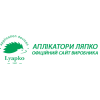Lymphatic system and Lyapko application therapy
1 The structure and function of the lymphatic system.
2 The mechanism of immunity is based on the interaction of 3 types of cells
3 What not to do with the lymphatic system
The structure and function of the lymphatic system.
The lymphatic system is one of the complexly arranged systems - a system of purification, removal of poisons, protozoa from the body. Human immunity, his life depends on this system.
The organs that form the lymphatic system occupy a tenth of all cells in the body and weigh about 5 kilograms. The lymphatic organs are the spleen, tonsils, and thymus (which develops into adolescence). Their main functions are to prevent the entry and development of infection in the body. Lymphoid tissue is located where there is a threat of bacteria action on the body. It protects it from infections, and also ensures the constancy of the internal environment of the body, through continuous cleansing of its degenerated cells.
When breathing, the air is not only moistened and warmed, but also meets an obstacle for microorganisms in the form of a nasopharyngeal ring, then, passing further through the respiratory tract, is rendered harmless by the lymphoid tissue of the bronchi and lungs.
But the largest accumulation of lymphoid tissue is in the digestive tract, since many microorganisms enter the body with food. Lymphoid tissue is presented here in the form of solitary follicles, Peyer's patches in the intestinal mucosa, the appendix of the cecum - the appendix.
The central organ of the lymphatic system is the thymus. He regulates its functions and determines its type. It is where the cells of the immune system mature. The thymus is located in the upper chest, just behind the sternum.
Lymph is a transparent liquid, colorless and odorless, consisting of water, salts, proteins, fats. In terms of its physicochemical properties, it differs from blood plasma only in the protein content.
Blood, passing through the arterial section of the capillary, is filtered through its wall into the surrounding tissue, while in the venous part of the capillary, fluid is sucked back from the tissue into the bloodstream. But not all the liquid returns, part of it forms the lymphatic system.
The lymphatic capillary has a special structure, it is a thin tube consisting of one layer of cells, between which there are gaps open to the intercellular tissue (Fig. 1)
Therefore, larger particles can be absorbed into the lymphatic capillary together with the liquid: colloids, emulsions, cells. Lymphatic capillaries are eight times wider than blood capillaries.
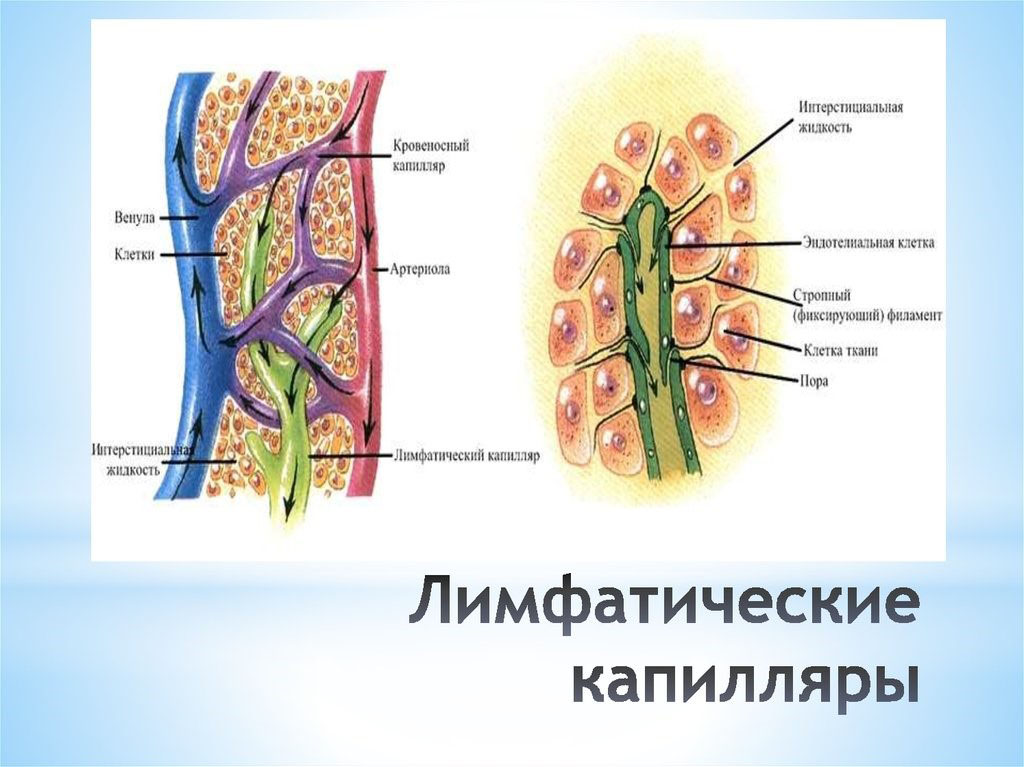
Fig. 1
They start blindly, intertwining with each other, form networks of different shapes. From the capillary, the lymph enters the post capillary, the movement of lymph in it occurs only in one direction due to the presence of a valve: from the bottom up and from the outside to the inside. Therefore, in order not to disturb the lymphatic system, massage should be done in the direction of movement of the lymph - from the bottom up. The speed of lymph movement largely depends on muscle contraction, the position of the person's body and his breathing. The main muscle for driving lymph is the diaphragm. With physical exertion and deep breathing with the "belly", the amplitude of the diaphragm's movement increases, and the circulation of lymph increases.
Lymph is collected into small lymphatic vessels, then into larger ones - collectors (Fig. 2). From the collectors, lymphatic trunks are formed, which are converted into ducts. They are called according to the parts of the body where lymph is collected: the vessels of the neck, forearm, thigh, etc. The main collector of the lymph collection is the thoracic duct, into which lymph flows from three quarters of the body, it flows into the left venous angle, a smaller part of the lymph (one fourth) is collected into the right duct and flows into the right venous angle. About 2 liters of lymph flows into the blood through the collectors daily.

Fig. 2
The lymph node - the most important element of the lymphatic system, makes up about 1% of the total body weight. It has a special complex structure, located along the lymphatic vessels (Fig. 3).
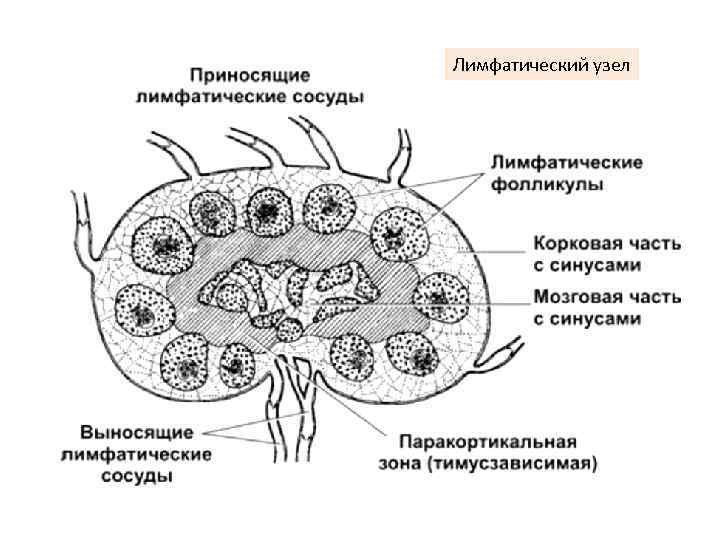
Fig. 3
Lymph node functions
The main function is participation in the immune mechanism. In the lymph nodes, the process of preparing lymphocytes for the body's immune defense takes place, the production of antibodies and their delivery by the blood stream to the focus of infection.
- Transport - contraction of the muscle elements of the lymph node capsule promotes active lymph flow through it.
- 2Barrier - passing through the node, the lymph is cleared of microbes, toxins, products of cellular metabolism. Lymph nodes play the role of a kind of filter that captures toxins and "releases" already purified lymph.
The mechanism of immunity is based on the interaction of 3 types of cells
The mechanism of immunity is based on the interaction of 3 types of cells: mononuclear macrophages, T and B lymphocytes.
Macrophagi (Fig. 4) - cells capable of actively capturing and digesting bacteria, the remnants of dead cells and particles foreign or toxic to the body They are present in almost every organ and tissue, where they act as the first line of immune defense against pathogens and play an important role in maintaining tissue homeostasis.
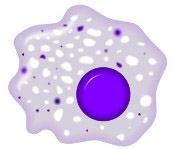
Fig. 4
Lymphocyte (Fig. 5) is a flexible, constantly transforming cell, the body's weapon to fight infection. Formed in the bone marrow, the blood stream enters the thymus, in which, under the influence of hormones, it turns into a T-lymphocyte. B-lymphocyte precursors, which acquire individuality in the lymph node, also leave the bone marrow.
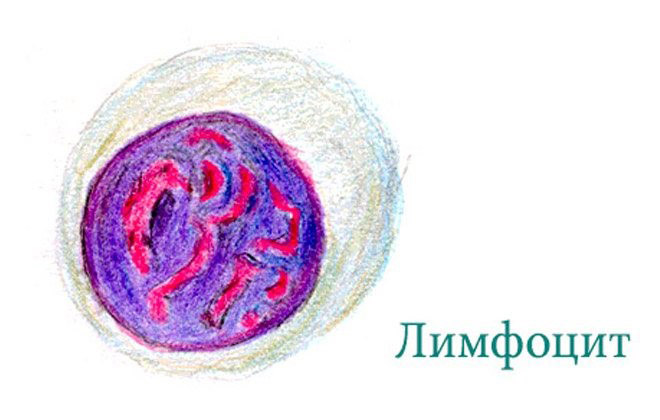
Fig. 5
What not to do with the lymphatic system
Lymph nodes, like the entire lymphatic system, should not be warmed or compressed. During the massage, the lymph nodes must be bypassed, since leukocytes live there, and with mechanical action or movement against the flow, they will die.
Lymph can be cleaned from the inside: only active movements, muscle contractions during gymnastics, playing sports can make it move.
If the functions of the lymphatic system are impaired, the lymphatic channel becomes polluted with harmful substances. The load on all organs of excretion and detoxification increases: liver, intestines, kidneys. Thus, the purity of the internal environment of our body is directly interconnected with the network of lymphatic vessels.
The lymphatic system, as well as the kidneys and the gastrointestinal tract, exits toxic substances through the mucous membranes. Removing them outside occurs through:
- vagina (in women) and urethra (in men);
- intestines - a huge amount of poisons are released through it;
- sweat glands, especially in the armpits;
- nose - the main amount of airborne infection is excreted through it;
- tonsils, larynx, trachea, bronchi, lungs.
The use of deodorants with a long-term effect leads to the fact that harmful substances are deposited in the nearest place - in the mammary gland, leading to mastopathy. It is necessary to give the body an opportunity to sweat - and then just wash it off.
Preventive measures for good lymph function
To cleanse the lymph, it is necessary to purposefully influence not only the lymphatic system, but also the functioning of the liver and intestines.
In the intestine, there is most of the lymphatic tissue, the transport of all fat-soluble substances passes through it, and toxins are removed. In the liver, the process of neutralization of substances brought by lymph is actively proceeding.
You need to eat right and monitor regular bowel movements. If the intestines and liver do not work properly, intoxication phenomena will increase in the body.
Also regularly engage in physical exercise, breathing exercises, and at work - industrial gymnastics.
Exercise until sweat appears, which is an indicator of a good warming up of the body, improvement of blood circulation and lymph movement.
Be sure to control your weight, not to overeat.
Regularly, twice a year, carry out sessions of lymphatic drainage massage, independently or with specialists.
The lymphatic system is well cleared through sweat at elevated temperatures. Therefore, it is recommended to go to the bathhouse once a week.
While visiting the bath, when taking a shower, you need to brush or washcloth 10-15 times over the body in the direction of lymph movement.
Good results are obtained by daily lymphatic self-massage of the body, diaphragmatic breathing, which are widely promoted by O.I. Shishova.
The restoration of lymph flow and capillary blood supply is facilitated by gymnastics Mikulina A.A.
Lyapko application devices are effective means of improving lymph and blood flow.
Lyapko application therapy
Lyapko applicators in various modifications (plates, rollers, applique belts, applique tapes) are an original, powerful device with many health-improving therapeutic capabilities.

Their action is based on the principles of traditional Chinese medicine - superficial multi-needle acupuncture, as well as general physiological mechanisms of life. More detailed information can be found in the article "Lyapko Applicators - Mechanisms of Action and Application Areas".
Lyapko's application therapy to the abdomen is indicated to improve the functioning of the abdominal organs, intestines, where the largest amount of lymphoid tissue is located, which is responsible for the functioning of the immune system.
To do this, it is recommended to use flat applicators on the lower thoracic and lumbosacral spine, in addition to the auxiliary zone - the anterior abdominal wall (simultaneously or alternately), you can also wrap these zones with the “Health Magic Tape” for 20-30 minutes or roll these zones with application rollers for 10-15 minutes.
Lyapko's application therapy is used both as an independent procedure and as a preparation for relaxing the muscles of the anterior abdominal wall for visceral abdominal massage.
These procedures improve the functioning of internal organs, relieve congestion, inflammation in them, restore the functioning of the lymphatic system, and increase immunity.
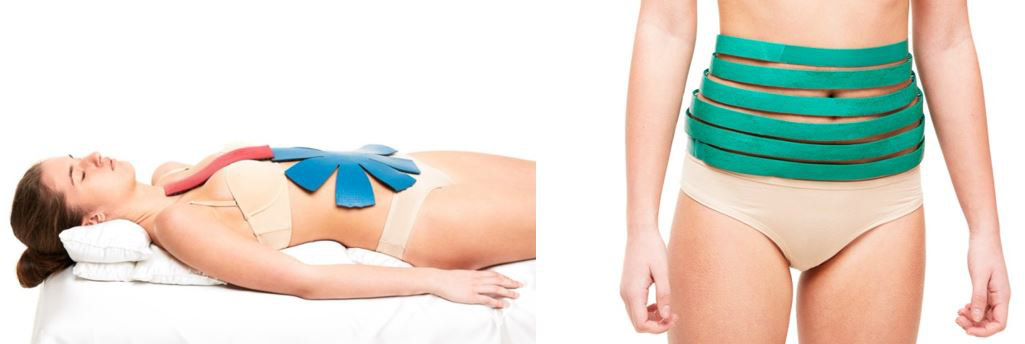
After the bath, the shower can be rolled in the whole body according to the above-mentioned scheme with the "Large M roller", "Universal M roller" for 5-10 minutes.

On the limb, you can apply the "Magic tapes" Health ", wind them in the direction of the movement of the lymph - from the fingertips to the body, on top of the tape additionally, to enhance the effect, do clamps with your hands in the same direction. After removing the tape, do strokes or light rubbing in the same direction.
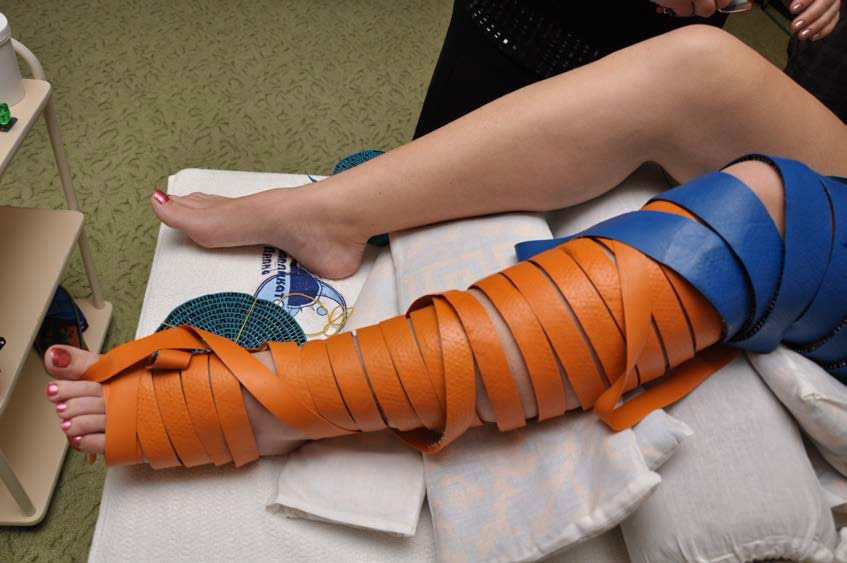
Use flat applicators on the torso: “Large rug”, “Large needle massage mat”, “Chance 6.2x4”.

"Chamomile M", "Quadro", "Chance", "Narodny", placing them both along the spine and across.

The exposure time is 15-30 minutes for a relaxing effect.
After removing the applicator, an anti-inflammatory cream, a cream with an anti-cellulite effect can be applied to problem areas, if necessary. The use of application therapy according to the above methods increases blood circulation, lymph flow, perfectly relieves fatigue, eliminates muscle tension and aches, pain, and increases vitality.
To improve lymph circulation, a complex procedure is recommended using Lyapko's applique suit and phytoparosauna.
"Physiotherapy" includes the following stages:
Using Lyapko's applique suit - 30–40 minutes.

Exposure to medicinal steam concentrate of phytoparosauna (cedar phyto-barrel) - 10–20 minutes.

Relaxation. It is recommended to drink 2-3 glasses of herbal lymph stimulating tea. Leaves of raspberry, currant, yarrow, strawberry, wild strawberry, lingonberry, rose hips, oats, etc. have such properties.
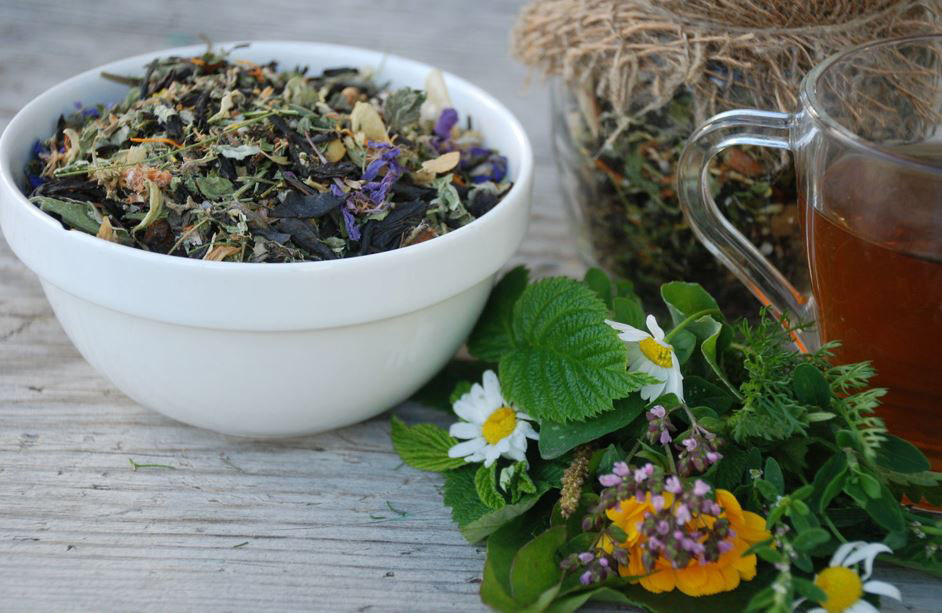
The complex is recommended to be supplemented by rubbing in a decoction of herbs, as well as manual massage or using the "Pharaoh", "Pharaoh L" massagers.
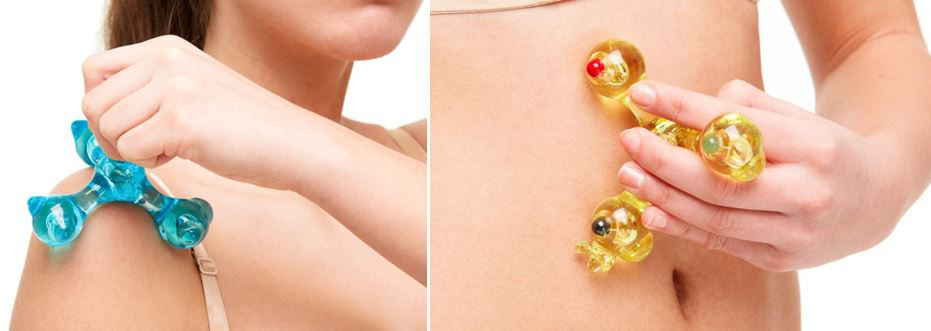
After such procedures, you will feel rested and full of vitality.
